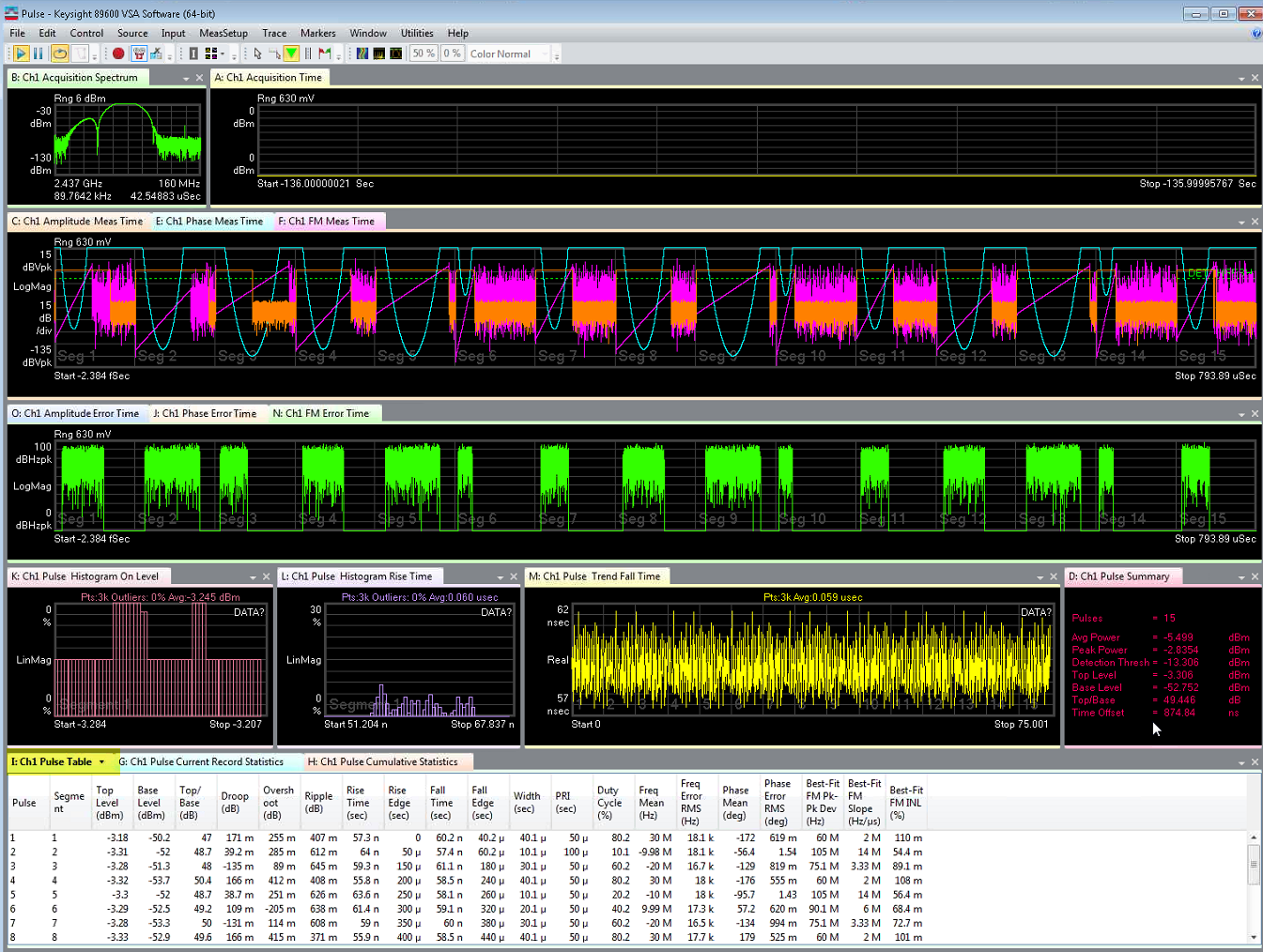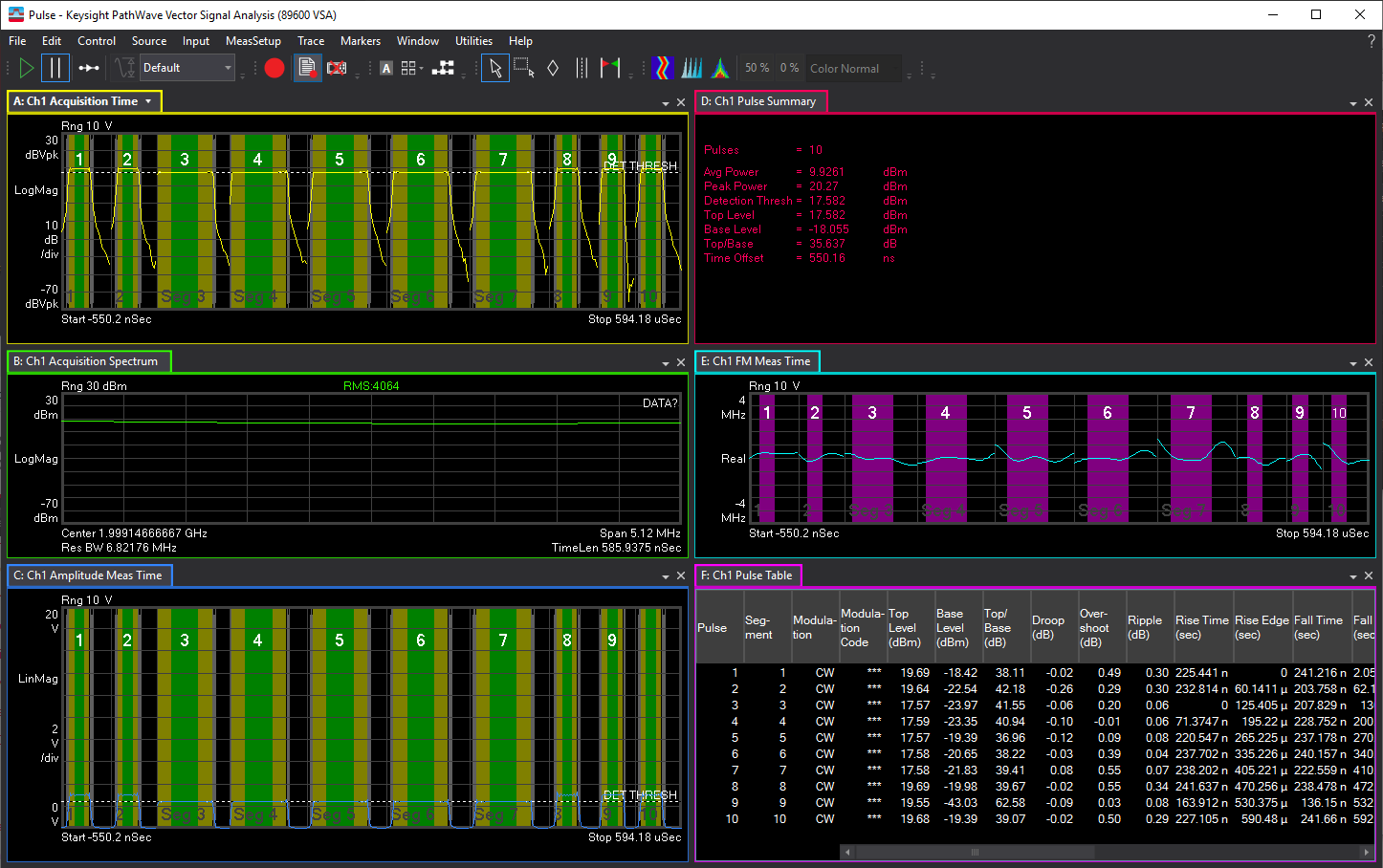Segmented Data Acquisition
This feature is not available for all hardware. See Measurement Platforms for more information about your hardware.
Segmented capture is supported with the Pulse Analysis and basic Vector Analysis measurements for hardware that supports segmented capture and for recorded signals that contain multiple segments. The VSA software detects the segments and automatically configures the appropriate segmented capture type (Fixed or Variable).
Segmented capture parameters are available in Pulse Properties > Time tab > Segmented Capture for Pulse Analysis, or in Input >Capture tab for either Pulse or Vector Analysis.
The VSA software offers two types of segmented capture:
Fixed Length Segmented Capture
Fixed length segmented capture (FLSC) acquires a fixed amount of data per segment. The segment starts acquiring when the signal crosses the defined trigger threshold, and stops after a fixed amount of data is acquired (based upon the current VSA measurement setup). Segments continue to be acquired until the specified segment count is reached.
Depending on what you are capturing, fixed-length segmented capture may capture too much data or too little data. Capturing too much data (e.g., long "off" times between "on" times) can consume large amounts of memory. Capturing too little data means that some of the "on" time might be missed and not included in the measurement. If you're having trouble capturing the right amount of data, variable length segmented capture may provide better results.
When running live signal acquisitions using segmented capture, the 89600 VSA software uses its normal time/RBW Resolution Band Width (RBW or ResBW): specifies the minimum frequency bandwith that two separate frequency spectra can be resolved and viewed seperately. For FFT (digital) based VSA's the process is equivalent to passing a time-domain signal through a bank of bandpass filters, whose center frequencies correspond to the frequencies of the FFT bins. For a traditional swept-tuned (non-digital) spectrum analyzer, the resolution bandwidth is the bandwidth of the IF filter which determines the selectivity. limiting to specify the length of a single segment, and then separately allows the number of segments to be specified. The measurement signal acquisition therefore contains an integer number of segments from the hardware. Each segment starts at a trigger point as defined by the input trigger settings.
When playing back a recording that contains segmented data, the Pulse Analysis measurement works the same as a live measurement, and allows multiple segments to be within each data block obtained from the recording. If the recording contains segmented data, the 89600 VSA software constrains the time/RBW settings to fit within a single segment, and then separately allows the number of segments to be specified – just like a live measurement. If the time/RBW settings require a shorter time length than the recording segment length, the measurement receives that time length from the start of each segment in the recording.
Partial pulses present at the start of a segment (such as only the falling edge of a pulse) and partial pulses present at end of a segment (such as only the rising edge of a pulse) are ignored and not included in Pulse Table results. Consequently, partial pulses are not included in metric calculations such as PRI (Pulse Repetition Interval). To ensure segments include entire pulses:
- Add a pre-trigger delay (negative Gate Start Delay), if required, so the acquisition segment includes the rising edge of the first pulse. This ensures a complete rise+fall sequence is detected for the first pulse in the segment.
- Increase the Segment Length (s) time value, if required, so the acquisition segment includes the falling edge of the last pulse. This ensures a complete rise+fall sequence is detected for the last pulse in the segment.
The illustration below shows a Pulse measurement with 15 fixed-length segments. Notice that the Result Tables now include a Segment column for each pulse. Also notice that the pulses may have different widths, but the segments are all the same width.

Variable Length Segmented Capture
Variable length segmented capture has the same basic objective as fixed length segmented capture, which is to capture only the desired parts of a signal in a series of segments. However, instead of acquiring a fixed amount of data in each segment, variable length segmented capture uses gated acquisition to control the start and stop of each segment based on gating criteria. For example, you can use IF Magnitude triggering to start capturing data when the rising edge of a pulse crosses the IF Magnitude threshold, and to stop capturing when the falling edge of the pulse again crosses the IF Magnitude threshold. This method of segmented capture removes long stretches of undesired "off" time from the acquisition, which can dramatically reduce memory usage.
If two pulses occur closely together in time, the VSA software may automatically capture them in a single segment for efficiency, instead of capturing them in two separate segments.
You can capture additional data before and after each pulse using the Gate Start Delay and Gate Stop Delay parameters.
- Gate Start Delay (a negative value) captures additional data before the gated acquisition trigger. This might be used ensure that the entire rising edge of the pulse is captured, or to simply add "off" time before the captured pulse.
- Gate Stop Delay (a positive value) captures additional data after the gated acquisition trigger. This might be used ensure that the entire falling edge of the pulse is captured, or to simply add "off" time after the captured pulse.
The illustration below shows a Pulse measurement with 10 segments. Notice that the width of each segment varies depending on the pulse width.

